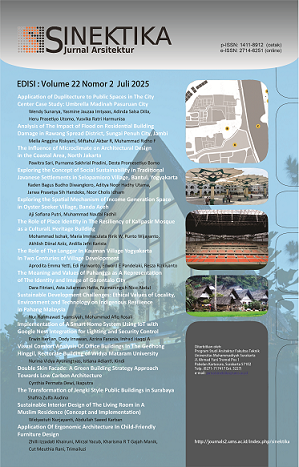Application of Duplitecture to Public Spaces in The City Center Case Study: Umbrella Madinah Pasuruan City
DOI:
https://doi.org/10.23917/sinektika.v22i2.4603Keywords:
Architectural Imitation, Duplitecture, Public Space, Religious Tourism, TourismAbstract
Duplitecture has become a captivating trend in Indonesia tourism. Duplitecture refers to the imitation or duplication of a popular architectural object that is intentionally built in a different place to enhance the tourist attraction within an area. Duplitecture usually adopts iconic architectural objects from foreign countries or those already globally famous. The trend of duplitecture invites debate because on one hand, it can be seen as plagiarism, but it can also be appreciated for its tourist appeal. This study examines the implementation of duplitecture in public spaces in downtown areas with a case study of Payung Madinah in Pasuruan City, East Java, mimicking the design of the Umbrellas of Al-Masjid An-Nabawi in Medina, Saudi Arabia. The aim is to investigate the important influences that limit or encourage the development of the duplitecture trend. Literature review was conducted in this research to discuss the duplitecture trend from various perspectives. Qualitative methods through field observation and interview were also applied to see the impact of the object existence. The study results show that the Payung Madinah in Pasuruan City has successfully become a positively impactful duplitecture object appreciated by the community. In addition to its unique shape, the object can provide functional space and offer new experiences to visitors in the downtown area. Its presence is strengthened by the religious tourism area around it, thus creating mutually beneficial benefits for the community, the image of the area, and its own existence.
Downloads
References
Ardhani, H. W. (2019). Monumen Simpang Lima Gumul Sebagai Ikon City Branding Kabupaten Kediri. Universitas Airlangga.
BBC. (2020). China 'copycat' buildings: Government clamps down on foreign imitations. Retrieved from https://www.bbc.com/news/world-asia-china-52585684?utm_medium=website&utm_source=archdaily.com
Bernhard, B., & Duccio, C. (2019). Copysites: tourist attractions in the age of their architectural reproducibility. Journal of Tourism and Cultural Change, 17(1), 13-26.
Bosker, B. (2017). Original copies: Architectural mimicry in contemporary China: University of Hawaii Press.
Buchrieser, Y. (2019). Simulacra architecture in relation to tourism: Charles Rennie Mackintosh in Glasgow and Antoni Gaudi in Barcelona. Journal of Tourism and Cultural Change, 17(1), 100-114.
Giovannini, J. (1983). ARCHITECTURAL IMITATION: IS IT PLAGIARISM. Retrieved from https://www.nytimes.com/1983/03/17/garden/architectural-imitation-is-it-plagiarism.html
Undang-undang (UU) Nomor 28 Tahun 2014 tentang Hak Cipta, 28 C.F.R. (2014).
Keating, S. (2021). When does influence become plagiarism in architecture? Retrieved from https://universityobserver.ie/when-does-influence-become-plagiarism-in-architecture/
Knight, B. (2020). Architecture: the fine line between inspired and copied. Retrieved from https://www.unsw.edu.au/newsroom/news/2020/09/architecture--the-fine-line-between-inspired-and-copied
Lang, J. C. F., Marta, R. F., & Menayang, A. P. (2020). Transformasi Identitas Kota Bitung Ditinjau dari Citra Pariwisata Heksagonal Anholt. Jurnal Riset Komunikasi, 3(2), 120-139.
Mayernik, D. (2016). The Challenge of Emulation in Art and Architecture: Between Imitation and Invention: Routledge.
Mesci, M., Comlekci, I., & Mesci, Z. (2019). Sustainable Tourism: Growth And Diversification. In A. Sharma (Ed.), Sustainable Tourism Development: Futuristic Approaches: CRC Press.
Ng, C. F. (2016). Behavioral mapping and tracking. Research methods for environmental psychology, 29-51.
Prischich, G. (2023). Europe Made in China: Exploring the Phenomenon of Chinese Architectural Replicas. Retrieved from https://www.rostraeconomica.nl/post/europe-made-in-china-exploring-the-phenomenon-of-chinese-architectural-replicas
Puteri, S., & Susetyarto, M. B. (2018). Imitasi Dan Desain Berulang: Apakah Suatu Pelanggaran? Paper presented at the Prosiding Seminar Nasional Cendekiawan.
Qothrunnada, K. (2022). 6 Fakta Menarik Simpang Lima Gumul Kediri yang Mirip Monumen di Paris. Retrieved from https://www.detik.com/jatim/wisata/d-7079699/6-fakta-menarik-simpang-lima-gumul-kediri-yang-mirip-monumen-di-paris
SEZGİN, B., TOPALOĞLU, S., ASASOĞLU, A., & KULOĞLU, N. (2019). REPLACING ARCHITECTURE BY CONSUMING TOURISM INDUSTRY. LIVENARCH VI, 125.
SL-Rasch. (2013). Medina Haram Piazza. Retrieved from https://www.architectmagazine.com/project-gallery/medina-haram-piazza
Sudiarta, I. M., Suharsono, N., Tripalupi, L. E., & Irwansyah, M. R. (2021). Analisis Dampak Perkembangan Pariwisata Terhadap Kondisi Sosial Ekonomi Masyarakat. Business and Accounting Education Journal, 2(1), 22-31.
Sui, D., Zhao, B., & Kong, H. (2017). The development of copycat towns in China: An analysis of their economic, social, and environmental implications: Lincoln Institute of Land Policy Cambridge, Mass.
Taryamin, A. (2020). people walking inside white buiding: Unsplash.
Yousaf, S., & Fan, X. (2020). Copysites/duplitectures as tourist attractions: An exploratory study on experiences of Chinese tourists at replicas of foreign architectural landmarks in China. Tourism Management, 81, 104179.
Downloads
Submitted
Accepted
Published
Issue
Section
License
Copyright (c) 2025 Sinektika: Jurnal Arsitektur

This work is licensed under a Creative Commons Attribution-NonCommercial 4.0 International License.











